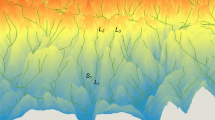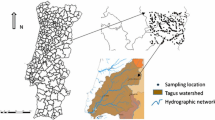Abstract
Heavy metals in mine wastes can considerably influence surrounding surface waters, soils, and human health. To estimate environmental impact, heavy metal concentrations in stream sediments can be utilized because they are indicators of contamination and change negligibly with time. This study proposes a new Kriging method to predict heavy metal concentrations in stream sediments. The proposed methods compensate for the drawbacks of Kriging based on Euclidean distance because they utilize the stream distance for the prediction by analyzing the stream path and networks using digital elevation models. Moreover, the developed method reduces the exaggeration problem in predicting the concentration of an uncontaminated stream segment by considering the catchment basin area in Kriging. Application of these methods to synthetic and real-world datasets proves that they exhibit improvement in terms of overall error reduction, and they provide reasonable predictions at stream junctions, rather than Kriging based on Euclidean distance.
















Similar content being viewed by others
References
Aelion CM, Davis HT, Liu Y, Lawson AB, McDermott S (2009) Validation of Bayesian Kriging of arsenic, chromium, lead and mercury surface soil concentrations based on internode sampling. Environ Sci Technol 43:4432–4438
Chiles J, Delfiner P (2012) Geostatistics: modeling spatial uncertainty, 2nd edn. Wiley, New York, p 734
Choi Y (2012) A new algorithm to calculate weighted flow-accumulation from a DEM by considering surface and underground stormwater infrastructure. Environ Modell Softw 30:81–91
Choi Y, Park HD, Sunwoo C (2008) Flood and gully erosion problems at the Pasir open pit coal mine, Indonesia: a case study of the hydrology using GIS. Bull Eng Geol Environ 67:251–258
Choi Y, Yi H, Park HD (2011) A new algorithm for grid-based hydrologic analysis by incorporating stormwater infrastructure. Comput Geosci 37:1035–1044
Cressie N (1985) Fitting variogram models by weighted least squares. Math Geol 17:563–586
Curriero F (1996) The use of non-euclidean distance in geostatistics. Ph.D. thesis, Kansas State University, USA
Dent CL, Grimm NB (1999) Spatial heterogeneity of stream water nutrient concentrations over successional time. Ecology 80:2283–2298
Heathwaite AL, Quinn PF, Hewett CJM (2005) Modelling and managing critical source areas of diffuse pollution from agricultural land using flow connectivity simulation. J Hydrol 304:446–461
Jenson SK, Domingue JO (1988) Extracting topographic structure from digital elevation data for geographic information system analysis. Photogr Eng Remote Sens 54:1593–1600
Khalil A, Hanich L, Bannari A, Zouhri L, Pourret O, Hakkou R (2013) Assessment of soil contamination around an abandoned mine in a semi-arid environment using geochemistry and geostatistics: pre-work of geochemical process modeling with numerical models. J Geochem Explor 125:117–129
Kim SM, Choi Y, Suh J, Oh S, Park HD, Yoon SH (2012a) Estimation of soil erosion and sediment yield from mine tailing dumps using GIS: a case study at the Samgwang mine, Korea. Geosyst Eng 15:2–9
Kim SM, Choi Y, Suh J, Oh S, Park HD, Yoon SH, Go WR (2012b) ArcMine: a GIS extension to support mine reclamation planning. Comput Geosci 46:84–95
Kim SM, Suh J, Oh S, Son J, Hyun CU, Park HD, Shin SH, Choi Y (2016) Assessing and prioritizing environmental hazards associated with abandoned mines in Gangwon-do, South Korea: the Total Mine Hazards Index. Environ Earth Sci 75:1–14
Lee S, Choi Y (2016) Reviews of unmanned aerial vehicle (drone) technology trends and its applications in the mining industry. Geosyst Eng 19:197–204
Lee H, Choi Y, Suh J, Lee SH (2016) Mapping copper and lead concentrations at abandoned mine areas using element analysis data from ICP–AES and portable XRF instruments: a comparative study. Int J Environ Res Public Health 13:1–15
Lin YP, Chang TK, Teng TP (2001) Characterization of soil lead by comparing sequential Gaussian simulation, simulated annealing simulation and Kriging methods. Environ Geol 41:189–199
Little LS, Edwards D, Porter DE (1997) Kriging in estuaries: as the crow flies, or as the fish swims? J Exp Mar Biol Ecol 213:1–11
Liu XM, Xu JM, Zhang MK, Huang JH, Shi JC, Yu XF (2004) Application of geostatistics and GIS technique to characterize spatial variabilities of bioavailable micronutrients in paddy soils. Environ Geol 46:189–194
McCool DK, Brown LC, Foster GR (1987) Revised slope steepness factor for the universal soil loss equation. Trans ASAE 30:1387–1396
Menafoglio A, Guadagnini A, Secchi P (2014) A Kriging approach based on Aitchison geometry for the characterization of particle-size curves in heterogeneous aquifers. Stoch Environ Res Risk Assess 28:1835–1851
MIRECO (2007) A report on the basic and detailed design of project for preventing loss of mine tailings at the area of Yeonhwa II mine, Samcheok-si, Korea. MIRECO, Seoul, p 508 (in Korean with English abstract)
Park CY, Park YS, Jeong YJ (1995) Contamination of heavy metals in soil in the Kwangyang mine area. J Korean Soc Miner Energy Resour Eng 32:163–174 (in Korean with English abstract)
Rathbun SL (1998) Spatial modeling in irregularly shaped regions: Kriging estuaries. Environmetrics 9:109–129
Salgueiro AR, Avila PF, Pereira HG, Santos Oliveira JM (2008) Geostatistical estimation of chemical contamination in stream sediments: the case study of Vale das Gatas mine (northern Portugal). J Geochem Explor 98:15–21
Shamsi M, Noaparast M, Shafaie SZ, Gharabaghi M (2016) Synergism effect of collectors on copper recovery in flotation of copper smelting slags. Geosyst Eng 19:57–68
Skøien JO, Merz R, Blöschl G (2006) Top-Kriging-geostatistics on stream networks. Hydrol Earth Syst Sci 10:277–287
Smith RA, Schwarz GE, Alexander RB (1997) Regional interpretation of water-quality monitoring data. Water Resour Res 33:2781–2798
Song J, Choi Y (2015) Design of photovoltaic systems to power aerators for natural purification of acid mine drainage. Renew Energy 83:759–766
Steiger B, Webster R, Schulin R, Lehmann R (1996) Mapping heavy metals in polluted soil by disjunctive Kriging. Environ Pollut 94:205–215
Suh J, Choi Y, Park HD, Yoon SH, Go WR (2013) Subsidence hazard assessment at the Samcheok coalfield, South Korea: a case study using GIS. Environ Eng Geosci 19:69–83
Thornton I (1983) Applied environmental geochemistry. Academic Press, San Diego, p 501
Torgersen CE, Gresswell RE, Bateman DS (2004) Pattern detection in stream networks: quantifying spatial variability in fish distribution. In: Proceedings of the second annual international symposium on GIS/spatial analyses in fishery and aquatic sciences, Fishery GIS Research Group, Saitama, Japan
VerHoef JM, Peterson E, Theobald D (2006) Spatial statistical models that use flow and stream distance. Environ Ecol Stat 13:449–464
White JG, Welch RM, Norvell WA (1997) Soil zinc map of USA using geostatistics and geographic information systems. Soil Sci Soc Am J 61:185–194
Wischmeier WH, Smith DD (1978) Predicting rainfall erosion losses: a guide to conservation planning (Handbook No. 537). United States Department of Agriculture, Washington, DC, p 58
Yenilmez F, Kyter N, Emil MK, Aksoy A (2011) Evaluation of pollution levels at an abandoned coal mine site in Turkey with the aid of GIS. Int J Coal Geol 86:12–19
Yuan LL (2004) Using spatial interpolation to estimate stressor levels in unsampled streams. Environ Monit Assess 94:23–38
Acknowledgements
This research was supported by Basic Science Research Program through the National Research Foundation of Korea (NRF) funded by the Ministry of Education (2015R1D1A1A01061290) and Research Institute of Energy and Resources (RIER), Seoul National University, Korea.
Author information
Authors and Affiliations
Corresponding author
Rights and permissions
About this article
Cite this article
Kim, SM., Choi, Y., Yi, H. et al. Geostatistical prediction of heavy metal concentrations in stream sediments considering the stream networks. Environ Earth Sci 76, 72 (2017). https://doi.org/10.1007/s12665-017-6394-2
Received:
Accepted:
Published:
DOI: https://doi.org/10.1007/s12665-017-6394-2




